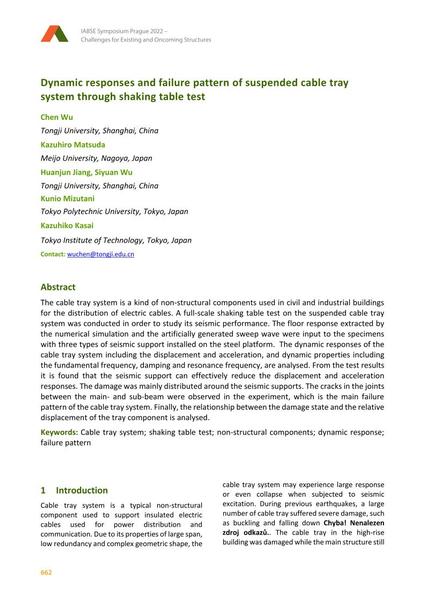Dynamic responses and failure pattern of suspended cable tray system through shaking table test

|
|
|||||||||||
Bibliographic Details
| Author(s): |
Chen Wu
(Tongji University, Shanghai, China)
Kazuhiro Matsuda (Meijo University, Nagoya, Japan) Huanjun Jiang (Tongji University, Shanghai, China) Siyuan Wu (Tongji University, Shanghai, China) Kunio Mizutani (Tokyo Polytechnic University, Tokyo, Japan) Kazuhiko Kasai (Tokyo Institute of Technology, Tokyo, Japan) |
||||
|---|---|---|---|---|---|
| Medium: | conference paper | ||||
| Language(s): | English | ||||
| Conference: | IABSE Symposium: Challenges for Existing and Oncoming Structures, Prague, Czech Republic, 25-27 May 2022 | ||||
| Published in: | IABSE Symposium Prague 2022 | ||||
|
|||||
| Page(s): | 662-669 | ||||
| Total no. of pages: | 8 | ||||
| DOI: | 10.2749/prague.2022.0662 | ||||
| Abstract: |
The cable tray system is a kind of non-structural components used in civil and industrial buildings for the distribution of electric cables. A full-scale shaking table test on the suspended cable tray system was conducted in order to study its seismic performance. The floor response extracted by the numerical simulation and the artificially generated sweep wave were input to the specimens with three types of seismic support installed on the steel platform. The dynamic responses of the cable tray system including the displacement and acceleration, and dynamic properties including the fundamental frequency, damping and resonance frequency, are analysed. From the test results it is found that the seismic support can effectively reduce the displacement and acceleration responses. The damage was mainly distributed around the seismic supports. The cracks in the joints between the main- and sub-beam were observed in the experiment, which is the main failure pattern of the cable tray system. Finally, the relationship between the damage state and the relative displacement of the tray component is analysed. |
||||
| Keywords: |
shaking table test dynamic response non-structural components Cable tray system failure pattern
|
||||
| Copyright: | © 2022 International Association for Bridge and Structural Engineering (IABSE) | ||||
| License: | This creative work is copyrighted material and may not be used without explicit approval by the author and/or copyright owner. |
||||
